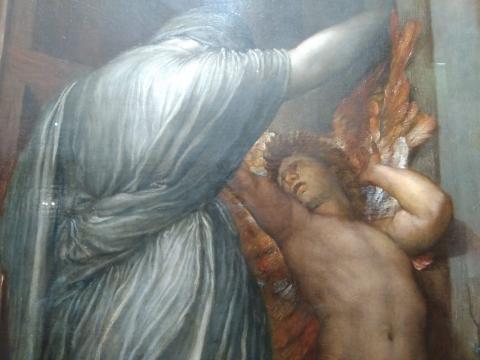Love and Death (1875)

George Frederic Watts’ Love and Death (1875) shows two very different figures meeting on a narrow porch. While the tall one on the left is seen from behind and attempting entry, his head bent low and clad in a draped shroud, the nude boy on the right fervently tries to prevent him moving forward and gaining entry. Watts had witnessed the slow decline of a talented young man who died despite all the loving care of his wife. He then painted this allegory showing Love trying to stop Death entering the House of Life. He explained:
“Love is not restraining Death, for it cannot do so; I wish to suggest the passionate though unavailing struggle to meet the inevitable”.
Love's colourful wings, natural complexion and the falling petals of the rose emphasises the cold tones used for Death, particularly the icy grey of shroud, and those pale, powerful arms. We Christians are not exempted from Death’s calls and visitations. It claims our loved ones, our friends and eventually, ourselves. Like Mary by Lazarus’ tomb in John 11, do we complain:
“Lord, if You had been here, my brother would not have died.”
Yet He replies:
“I am the resurrection and the life. He who believes in Me, though he may die, he shall live. And whoever lives and believes in Me shall never die. Do you believe this?” (vv25-26).
Death continues to claim its entitlements and dues, it continues to snatch and impound. Yet our Saviour has conquered death; what it takes it only borrows, for its redeemed victims must be returned to their Owner, the Living One.
- Log in to post comments


 Sunday Worship 10.45am & 6.00pm
Sunday Worship 10.45am & 6.00pm